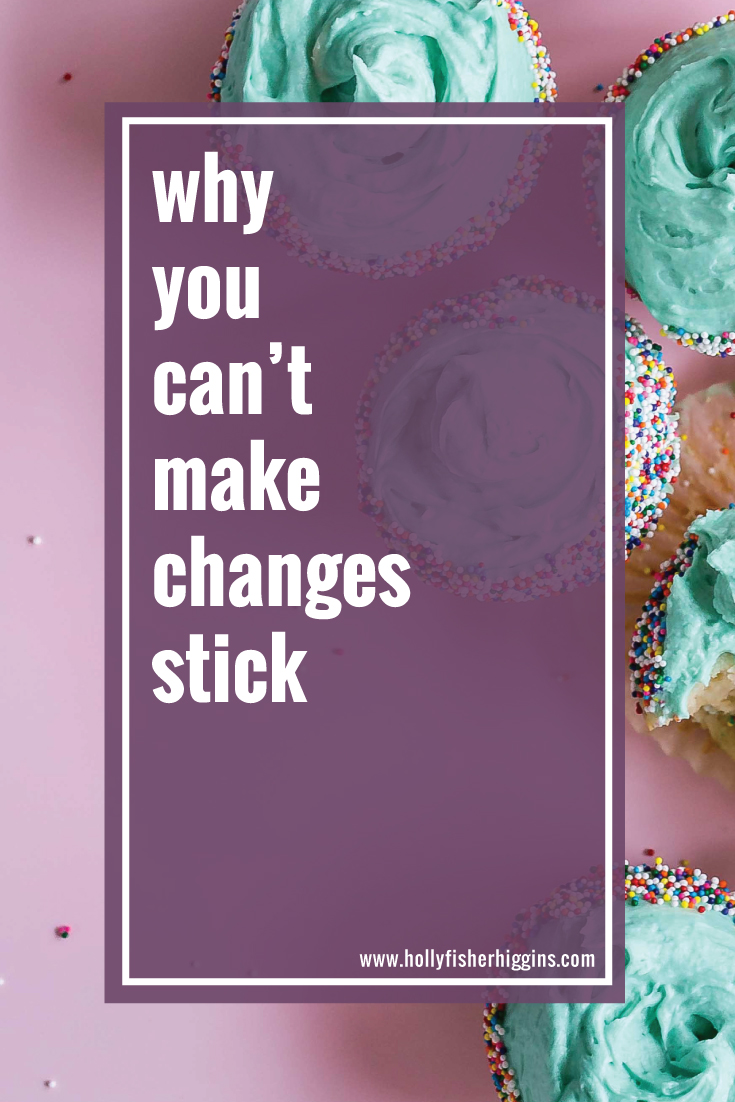
“Why do I get excited about change for two weeks, and then throw in the towel?”
“Why can’t I be consistent?”
“Why are others so successful with change, but I always struggle?”
If you’ve asked yourself these questions, you’re not alone.
And there’s more good news: You’re not lazy or incapable. You don’t have bad genes. And no matter what kind of situation you’re in, it’s not the situation’s fault, either.
In an effort to help my clients reach their goals, I’ve spent the last year reading dozens of books about habit change, personal development, mindset, growth, and success.
Because let’s face it — I can yammer on about the importance of B vitamins, adrenal health, pasture-raised meats, and a healthy gut microbiome all day, but if you can’t implement that information and get results, IT’S USELESS.
I can’t take personal responsibility for your success. You have to put in the work, and you have to want your life to change just as much as I do. However, I do take responsibility for being a good coach and helping you shift the roadblocks that are holding you back.
What I’m about to tell you is deceptively simple, but incredibly powerful. If you gloss over this, you’re going to keep being stuck.
The difference between those who are successful with long-term change and those who aren’t is how they talk to themselves all day.
That’s it. A year’s worth of reading wrapped up in one sentence.
If you want better results, you have to find a way to convince yourself that those results are possible, and then tell yourself that they’re possible ALL DAY LONG. Otherwise, your brain is going to be an asshole. It will tell you that you suck and that you’re going to fail. And then you will fail.
It really is that simple.
But HOLD ON — before you close your browser, I’m going to break it down for you in a way that makes sense.
In the video below, I’ll show you how to change it — once and for all.
Don’t feel like watching the video? Scroll down and keep reading.
Your Thoughts Create Your Reality
Have you ever heard the saying that your thoughts create your reality?
I used to think it was a bunch of woo-woo hogwash, but it’s absolutely true. If you’re skeptical, bear with me.
Here are the most common thoughts I hear from people who are struggling with sticking to a nutrition plan:
It’s too restrictive.
I feel deprived.
I feel like a weirdo and worry that people will make fun of me for what I’m eating.
What if I try it and it doesn’t work for me?
This is unsustainable and there’s no way I can do this long term.
Now, just to keep it simple, let’s pick one of those thoughts:
It’s too restrictive.
How are you going to feel if you’re thinking that thought all day?
You’re going to feel small, sad, left out, deprived, and frustrated.
When you feel that way, how do you act?
In order to buffer those feelings of pain, you might eat a plate of cookies. That’s the rebel tendency in you.
“I can’t have cookies? Oh yeah? Well, I’m sick and tired of feeling so deprived, so I’m gonna have cookies if I damned well please.”
So what’s the result?
After you eat the cookies and the sugar high wears off, you’ll be mad at yourself for not sticking to your goals (and you might have a stomachache, too).
The Model
It makes more sense when you see it written out like this:
Circumstance: Trying to eat healthier.
Thought: My nutrition plan is too restrictive.
Feeling: Deprived and frustrated.
Action: Eat a plate of cookies.
Result: Mad that you didn’t stick to your goals. Stomachache.
This is called “The Model,” and I learned it from a coach named Brooke Castillo. It’s not unique. A lot of people have dissected behavior and habit change in similar ways, but Brooke’s “Model” is the first thing that made it click for me in a HUGE way.
Our circumstances trigger our thoughts.
Our thoughts create our feelings.
Our feelings drive our actions.
Our actions determine our results.
If you can consciously choose a new thought (and keep it!), you can create a different outcome for yourself.
Watch what happens just by choosing a new thought:
Circumstance: Trying to eat healthier.
Thought: I am encouraged by the changes I’ve seen and I’m ready to see more.
Feeling: Inspired and hopeful.
Action: Reach for a healthy snack instead of cookies.
Result: You avoid the consequences of eating cookies and feel good about sticking to your plan.
THE ONLY THING THAT CHANGED WAS THE THOUGHT.
Really let this sink in … if you weren’t held prisoner by your crappy thoughts, what might be possible for you?
An entirely new life, that’s what.
I get it. This seems simple and easy “on paper.” You may be rolling your eyes — especially if you struggle with depression and anxiety.
“But I’ve been fighting my brain for YEARS,” you say. “I can’t just go and change my thoughts.”
You can. You may have to fight for them, but eventually you will form new neural networks in your brain, and your new thoughts won’t feel so hard — they’ll be automatic.
I know it works because I’ve been doing this unconsciously for years.
When I first changed my lifestyle, I had all of the same crappy thoughts that you’re likely struggling with.
But I wanted change so desperately that I chose to see my situation in a different light.
Instead of saying, “UGH, shopping for healthy food is such a pain,” I changed my story to, “I am so grateful that I get to eat healthy food and heal my body.” And I told myself that all day long.
And that made ALL of the difference. It’s the only reason I’ve maintained my healthy lifestyle for the last several years.
Action Steps
Your brain is huge and filled with tons of thoughts. If you really start listening to what you tell yourself on a day-to-day basis, you’ll be shocked and overwhelmed. So here’s how I recommend you start:
1) Pick one area of your life that you want to improve.
2) Carry around a notebook for a day or two and write down the thoughts you have about this area of your life, good or bad.
(Examples: Eating healthy is too hard. I’ll never lose weight. Why is it so easy for other people? What if I have depression forever? What if I never get out of debt?)
3) Choose your most pervasive negative thought and plug it into the model so you can see how it’s impacting your life. Here’s an example:
Circumstance: Wanting to stick to a healthy eating plan.
Thought: Eating healthy is too hard.
Feeling: Defeated, exhausted, sad.
Action: Get food from the drive-thru.
Result: My stomach is upset from bad food and I’m disappointed in myself.
4) Once you’ve seen how your current thought is impacting your life, choose a new thought to replace it.
The only criteria is that the thought has to make you FEEL GOOD. It doesn’t have to be outrageous or ridiculously cheerful — it just has to be honest and true for you, and it has to make you feel good. For this example, we will use the thought, “I love how I feel when I eat healthy, and I’m willing to spend extra time on it.”
5) Plug your new thought into a new model and see how it could change your results:
Circumstance: Wanting to stick to a healthy eating plan.
Thought: I love how I feel when I eat healthy, and I’m willing to spend extra time on it.
Feeling: Determined, optimistic, content.
Action: Go grocery shopping for the week and prepare healthy meals.
Result: I feel good about my choices and I feel better physically and mentally.
6) Practice your new thought multiple times per day.
Here’s the thing: your brain will not stop being an asshole overnight. It will want to resist. It will tell you that thought work is stupid, and that changing your thoughts is impossible. IGNORE IT!
Write your new thought on index cards. Write it on your mirrors. Keep it on a piece of paper in your wallet. Have it in front of you multiple times per day, read it to yourself, and feel what it feels like to really believe that thought.
Watch and notice how your life changes.
7) Detach from setbacks.
This one’s SUPER IMPORTANT — if you do something you wish you wouldn’t have, you can’t make it mean anything. You must move on.
Let’s say you eat a piece of cake, even though you’re trying to avoid gluten and sugar.
You could make it mean that you’re a failure, a bad person, and incapable of sticking to your goals.
Or you could make it mean that you had a piece of cake — that’s it.
The circumstance (having the cake) is the same, but the thoughts are completely different.
Move on with the next meal (or situation), and stay anchored in your feel-good thought.
Nothing means anything unless you make it mean something.
Questions?
Have questions about the process? Let me know in the comments!
If you want help with your nutrition and your thought patterns, I do this work with clients in my Mental Health Nutrition Program. Sometimes it’s hard to uncover the thoughts that are keeping you stuck, and having an outside perspective can really help.


Holly, this is so helpful! My brain is an asshole like 80% of the day. I’m going to try what you suggested in my journal. I love that it has an activity component to it. Thanks!
Hi Karen! I’m so glad you found it helpful. My brain is an asshole most of the time, too — I’ve just figured out ways to wrangle it. Let me know how it goes!
This advice is exactly what I was looking for to help encourage change. I have a lot of things I want to change and I feel so defeated constantly and I needed to see this to know I’m normal and not at all failing, I’m just starting a hard but rewarding journey.
I’m so glad it helped you! Keep going!